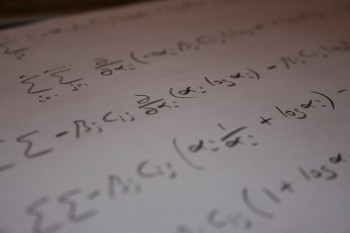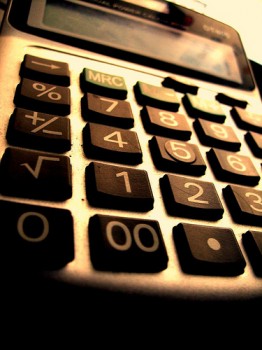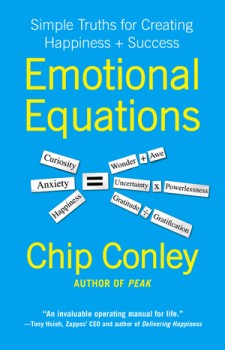In Martin Seligman’s book, Authentic Happiness, he uses a simple equation to describe where happiness comes from:
H = S + C + V
Where “H is your enduring level of happiness, S is your set range, C is the circumstances of your life, and V represents factors under your voluntary control.”
I hear Seligman take a lot of flack for this equation in scientific circles. There are those who think this is an oversimplification of how happiness works, and that describing it as a simple sum is faulty math in calculating the complex relationships between the variables.
Here’s Barbara Ehrenreich, bashing Seligman in her anti-positivity opus, Bright-Sided:
I move on to one of the most irritatingly pseudo-scientific things in his book, the “happiness equation,” which he had introduced with the coy promise that it “is the only equation I ask you to consider,” as if positive psychology rests on whole thickets of equations from which the reader will mercifully be spared . . . Now I understand what he is trying to say: that a person’s happiness is determined in some way by their innate disposition (S), their immediate circumstances (a recent job loss or bereavement, for example), and by the efforts (V) that they make to improve their outlook. This could be stated unobjectionably as:
H = f(S, C, V)
Or, in words: H is a function of S, C, V, where the exact nature of that function is yet to be determined. But to express it as an equation is to invite ridicule. I ask the question that would occur to any first year physics student, “What are the units of measurement?”
I’m sure mathematically, Ehrenreich is correct, but she’s missing the point. The equation is not intended to be filled in with actual numbers, as if you could calculate your happiness with the ease of pressing buttons on a calculator. It’s simply a way to describe a complex subject in a way that is easier to understand.
The point of the equation is pretty simple:
Some of our happiness is fixed (genetically programmed, perhaps), some is influenced by the conditions we find ourselves in (where we live,health, wealth and marital status, political and cultural factors, etc.), and some is subject to change through voluntary control. Because the V can be influenced, this is the area where, according to Seligman, positive psychology should focus.
Sonja Lyubomirsky also has taken some heat for attaching some percentages to this equation and showing that about 50% of the variance in happiness can be explained by genetics (the set-point or S above), only about 10% by our circumstances (C), and that leaves a whopping 40% that is subject to voluntary influence (V).
The criticism here is somewhat better founded. These percentages are based on variances across large populations and don’t tell us much about individuals (your personal mileage may vary.) And there’s a bit of a leap here to assume that you can truly manipulate whatever falls outside of what’s been found in genetics and circumstance.
But these criticisms still miss the point. Lyubomirsky is using a simple pie chart to communicate three important facts about human happiness:
A lot of it is set (maybe about half).
Some (a lot less than we think) is dependent on our circumstances.
And, there is a chunk left over that is within our power to change.
I find this not only useful, but a powerful message to share with those who may be assuming that their happiness in life is determined completely by factors outside of their control
Another man who uses simple equations to explain deep human truths is Chip Conley, the author of Emotional Equations (and one of my heroes in the hospitality industry.)
His formula for happiness is as follows:
Happiness = Wanting What You Have / Having What You Want
Here, the equation brings to mind Buddhist principles of acceptance and how a shift in mindset can increase happiness more than merely attaining or accomplishing more. Again, the math is flawed because the equation suggests that having more would cause your happiness to plummet, but once again, that’s not the point.
Conley uses equations to explore relationships. There is a relationship between wanting and having that is described here. Most people focus on having more, but Conley’s equation asks us to think about wanting less (or better yet, wanting and appreciating what we already have.) His book is filled with simple equations to help readers come to terms with the factors that allow certain emotions to rise and fall through life.
For me, all of these equations are useful. They force us to use an analytical part of our brain to consider the forces at play between variables that are unquantifiable. To the critics of these equations, I’d like to share the same advice that Conley gives to his readers . . . “try not to let the math distract you from the bigger message.”
p.s. What would your happiness equation be? I think mine would be something like this:
Happiness = (Meaningful Work + Joyful Play + Loving People) * Time to Appreciate It
—
References and recommended reading:
Conley, C. (2012). Emotional Equations: Simple Truths for Creating Happiness + Success.
Ehrenreich, B. (2010). Bright-Sided: How Positive Thinking Is Undermining America. Picador.
Lyubomirsky, S. (2008). The How of Happiness: A scientific approach to getting the life you want. New York: Penguin Press.
Seligman, M. E. P. (2003). Authentic Happiness: Using the New Positive Psychology to Realize Your Potential for Lasting Fulfillment. Free Press.




Great arguments, Jeremy!
I like your equation the best – that’s the most usable one so far! 😉 I would suggest a change however: rather than “time to appreciate it”, I’d use “availability”… availability includes time, but it also includes other factors, like mental state, stress, external circumstances, etc.
Sonja and Marty’s equations are meant to show us that a lot is under our control, which I think is an idea that made a lot of progress. Your equation on the other hand is all about what’s under our control, and we have to keep in mind that circumstances/genetics/other factors still play a role in that equation.
That being said, I’d rather err on the side of making it more about our choices than less, because it fosters accountability and action. (But I still like a little exterior influence so it’s not overly guilt inducing!) 😉
MarieJ
As I’m married to a physicist, I feel compelled to comment on this post. 🙂
The difference comes when the equation is an actual mathematical proof, or if it’s a heuristic. Like Ehrenreich says, if it’s an actual mathematical model, you need to know the units, and you expect a precise answer. Like in Newton’s F=ma (where forces = mass times acceleration), the units must all line up and you can manipulate the equation so that a = F/m and so on. This gives us a precise answer to a precise question.
However, the question of happiness is not precise, which means that “happiness equations” are heuristics – they are shortcuts to indicate our understanding of how different factors affect the outcome (being happiness). Where we get into trouble is that positive psychology undeniably prides itself on its strong empirical base, which rests (in large part) in statistics which is filled with mathematical equations of the F=ma variety.
Statistics does not equal heuristics, and when people read about the ‘science’ of positive psychology, and then see an equation, they expect that the equation is a real mathematical equation. In some ways, you could argue that we are the victims of our own success – at least people know that positive psychology is based on science, statistics and math!
When someone gets upset that another person has (mis)quoted a statistic that 40% of happiness is within our control, arguing that this point is actually a range and doesn’t accurately portray the science, both sides are right – one is using a heuristic masquerading as a mathematical model; the other is using a mathematical model masquerading as a heuristic.
We just need to be clear in our communications – do we really mean 40% (as a short-form way of saying “about 40%”) or do we mean 40% is a fixed point that’s empirically sound. Other fields also use approximations – it’s not outrageous, especially in the social sciences (though my undergrad university, which was engineering-dominant, used to refer to “good enough for engineering…”). We just need to be clear – and understanding that the numbers can be used in different ways.
Lies, damn lies, and statistics!
http://en.wikipedia.org/wiki/Lies,_damned_lies,_and_statistics
I think this is a great article whose take home message for me is to focus on the elements of our happiness which we can control and appreciate. I am sharing your message with my blog readers as I’m sure they will enjoy it too. Thanks also for the book list – I was familiar with all the books apart from the Chip Conley one which I will take a look at.
The “equation” that seems to work best for most people I know is as follows:
Happiness = Reality – Expectations
All these models are overly simplistic and don’t take into account obvious interactions.as well as other factors like age, time, culture etc
simplistic models produce simplistic thinking
One of the ironies of the popular success of positive psychology is that the very things that appeal to those in the “applied” world or involved in interdisciplinary research and teaching – simple formulations or shorthand expressions illuminating big ideas – are those that drive many people crazy, particularly the “purer” scientists amongst the pp community. Look, I cringed when I saw the infamous pie chart on the cover of Sonia’s book at the Barnes and Noble as I am sure many of you did. However, if it helps make a larger point to a larger group of people, good. I know that over the course of a semester teaching Duke law students about well-being and its relationship to ethics a formulation such as Marty’s is quite sufficient to make the point that well-being is not only a function of fate and circumstances (unlike the pre-Socratic definition of eudaimonia, literally translated “good demons”) but by a number of factors, including their own actions and beliefs. That is sufficient for my pedagogical purpose where I am not training psychologists but exposing law students to important new concepts.
After discussing the happiness equations in class my students are often threatened to see such a big proportion of the pie devoted to genes, at least more than they expected. Reassuring however is that almost the same proportion is within their control. This realisation comes with a sigh of relief, presumably because they become hopeful that they may uarness their autonomy, free will, and choice towards a positive future. With choice comes responsibility, and with responsibility comes growth.
I agree that these equations are not about the numbers and the functions, but about the relationships and implications of these factors, and the fundamental goal of PP: achieving a life above zero. Whether precise or not, these equations seem to work, and as well as scientists we are practitioners…
It was interesting and useful to see each of the equations on one page. When I first came across the H = S + C + V equation, it was like my mind had been blown. Unlike Barbara, I never once considered what the units would be. I didn’t care – the equation was a general perspective; one that is much different from commonly accepted theories of happiness.
My equation would be:
Happiness = Mindset * (.5(Energy Level – Chronic Pain) * (Meaningful Work + Loving People) * Appreciation – Genes)
Authentic Happiness?? 2FUNNY!
Anyone that has it knows it well and those that do not will Never have it until they can re-program their sub-conscious that Rules them 90 to 95 percent of thier Lives..It’s just that simple…
What a waste of life talking about lots of Crap above, clearly a great debate for those that are not Happy much, only way to say it!
Reminds me of the Frustraed VP from the Leading Spa company that said ” Canyon Ranch has a machine that Proves if your a healer or not”…
Visting a Psychiatrist for 95% of us is a SCAM, How many of you really have a Mental Disorder?
Psychiatry is the medical specialty devoted to the study and treatment of mental disorders.
True Happiness comes from focusing on Love, helping others and staying in the moment by constantly looking for and talking about that Beauty which surrounds all of us in Millions of ways daily, second by second….
Cambridge U. recently finished a long study where they say” your body controls many thoughts”
Interesting,?
Amygdala, Nervous system, and the Heart rule…not necessarily in that order..
Al the seeker will Keep seeking until You Look with-In, only then will you move on and only by staying in a state of parasympathetic is that POSSIBLE…
The sympathetic nervous system has an active “pushing” function, the parasympathetic has mainly a relaxing function.
Love!
Take some time off and go Within, you’ll be glad you did.
Hi Jeremy,
Reached this article from your facebook link. First of all, thanks for taking the time out and putting out this easy to ‘read and understand’ article. I appreciated the fact that you have cogently brought out the essence of what each researcher had to say and the debate there in [which a lay person could also understand]. The informed debate and opinion this has generated is a testament to that.
I feel having Mental and Emotional discrimination is the essence of it all . To be in the moment of learning and applying this subject and at the same time being aware of your emotional reality of experience and the maths / heuristics of it. Self awareness of where you stand and where science is and how you marry them both for sustainable growth and transformation is where our unique interpretation and individuality comes through. This i see in myself, in the researchers and other professionals trying to apply and disseminate PP.
Thanks again for your input. Enjoyed reading it and the responses.